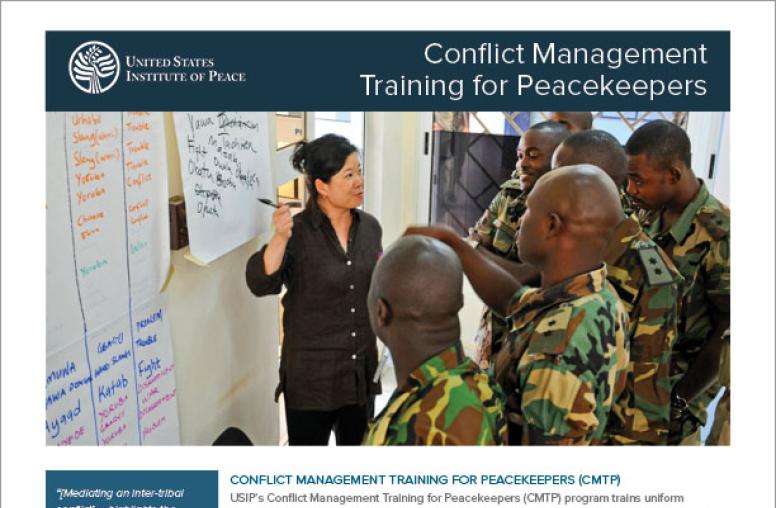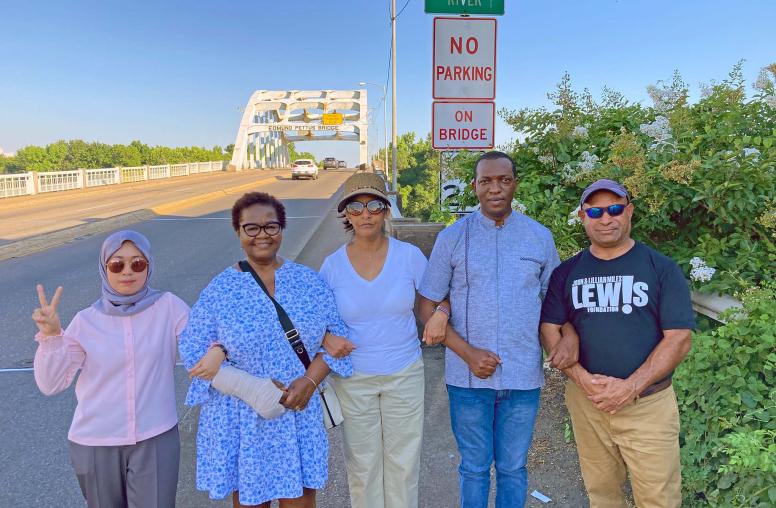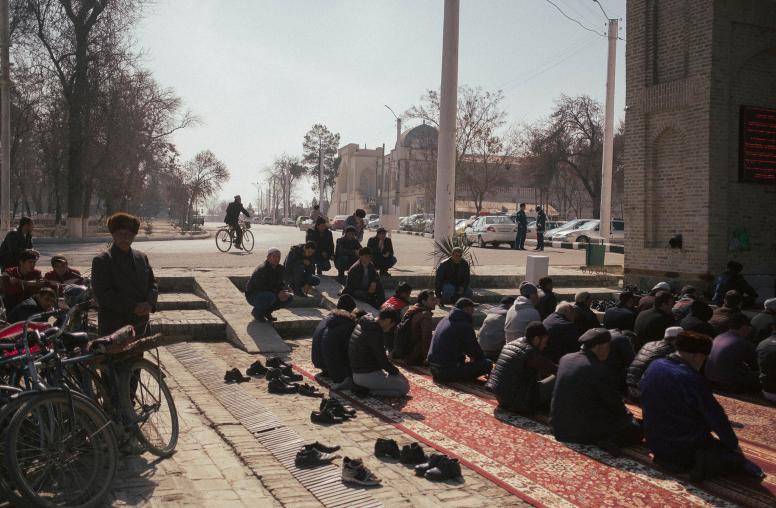When seeking solutions, give people space — and watch what they create
Culturally Attuned Podcast: Episode 15
Working across cultural divides makes it all the more critical that we avoid prescribing solutions to problems, and instead elicit them from those we’re working with. That is Mike Zuckerman’s career-long focus—from San Francisco to Greece to Uganda. He discusses how he does it.
How can we work effectively across our world’s cultural divides? USIP and Burning Man Project travel to that frontier, hearing stories and practical lessons for working in unfamiliar cultures. The Culturally Attuned podcast complements USIP’s online, self-paced course on Cultural Synergy. Both help us cultivate the skills we need to do good work in a diverse world.
Transcript
This is Culturally Attuned. Brought to you by the United States Institute of Peace, in partnership with Burning Man Project.
Mike Zuckerman
Find a space, figure out a way to get people to show up, and then ask them what they want to do. And really that’s kind of the three step process that I’d say is present in all of my projects I have done in international development.
Dominic Kiraly
When working as outsiders in a community, how can we avoid prescribing our own responses to problems–and instead collaborate with local people to help them develop their own, better-grounded solutions?
I’m Dominic Kiraly, and our guest today is Mike Zuckerman who has led relief and development projects around the world. From refugee camps in Uganda and Greece, to inner-city projects in San Francisco and Detroit, Mike shares his stories on how to effectively elicit ideas and expertise from local stakeholders, rather than prescribing solutions to problems as an outsider.
First up, we head to San Francisco where Mike was working with the organization Free Space.
Mike Zuckerman
Free Space was an experiment to see what happens when you give people the gift of space. And it was an homage to the Diggers, a crew here in San Francisco back in the 60s, that you can actually trace the lineage of Burning Man back to. They had a free store, they had free food, they did free theater. And at their free store, one of the kind of famous quotes was people would say, like, who’s the manager here? And they say, “You are.” And they say, “Well, why is it free?” And they say, “Because it’s yours.” And, you know, they really kind of played with this concept of life acting, to act as if. So Free Space was this concept as well, that was confusing to people, they show up, like, what is this? And you’re like, it’s yours. What do you want it to be?
And so we rented a building here in the crazy real estate market of San Francisco for $1, for the month of June 2013, for the National Day of Civic Hacking. And we created a set of principles, no money was allowed inside, no ego, no logo. Everyone’s a participant, and set up a governance structure, that was an adhocracy, the opposite of a bureaucracy. That there’s some aspects of meritocracy where you get people to follow you based on what you’ve done, but also this kind of do-ocracy of just do it.
People would show up and say, hey, you should do this over here or you should do…and we would say, “Did you just should on the floor?” There was really this like, don’t should, just do it. And so by this governance structure of anyone can show up and become a leader, really kind of allowed this mass participation in transforming an abandoned space into this really vibrant, beautiful and filled with stuff space called Free Space, that really was a turning point for me and my activism career in creating space, where kind of really distilled down this concept of just give the space and create the conditions where people feel like it’s theirs. And that has been done in 17 different countries, and all sorts of different cultural contexts. And what’s really wonderful about the blank canvas, the tabula rasa of an empty building, that it can be filled in any city around the world by its participants in a completely unique way that also feels very local. And it’s populated by people and ideas and artifacts of the current time and current place.
And even going to Detroit, it’s a really hard place to show up to as an outsider. Rightfully so, people are pretty sick of people showing up, and saviors and taking advantage of the inexpensive prices. But what we did was we just offered a space; we had a barbecue, potluck, and just kind of said, what do we want to do with this space? And it wound up becoming one of the most kind of activist-focused free spaces that we’ve had. Most of them were more cultural with art and performance, but the Detroit Free Space, they had real crises. They had a water shut-off issue, where people, residents of Detroit were having their water shut off by the thousands, which is a messed up thing. That’s a Sun Tzu tactic, to cut off people’s water. And so allowing the freedom of a space to take whatever form the participants show up and do, that’s kind of the key. Because it’s a tough thing to do. Because as you gain more experience, as you’re more knowledgeable in the field, you really kind of want to have your imprint on what it is. You say I kind of know what works or I did it here, so I know what’s necessary here, but really staying true to the process of whatever it becomes, allowing that to become what it is and not get in the way, is really what allows the locals to feel and to actually have it be theirs. And they came up with the phrase also, instead of the field of dreams, quote, “If you build it, they will come”, to, “If they build it, they will stay.”
And it’s a constant struggle; I wouldn’t say I’ve mastered this because there are times where it seems like it’s going off the rails or in different directions. But I try to stay as true to the process of, provide the space, and allow what wants to emerge to emerge.
Dominic Kiraly
Before going into another culture it’s important not only to learn about that culture – that place and its people. It’s just as critical to “unlearn” – to step back from one’s assumptions and preconceptions. A community may lack resources and tools, but it is not lacking in knowledge and skills.
Mike Zuckerman
I learned a lot in doing free spaces in communities that I had never been to, and cities I hadn’t been to and countries where I didn’t speak the language, but this pursuit of what are these universal principles that create this sense of agency, and also mass participation. And I think that’s kind of one of the central themes that my work and my research is around. And taking that to different cities is certainly a way to test that, but also taking it to kind of extreme crisis situations is another venue to experiment with, “Do these things work of giving people space, leading with culture, and kind of instilling this spirit of participation in agency?”
So, in the summer of 2016, I received an email asking if I was available or I knew anyone who wanted to come to Greece to try and build a new model for a refugee camp. And because of my experience with Free Space, the donor, the philanthropist, who had given a lot of money to a large NGO went and visited and was really disgusted by the conditions that were present for the migrants in Greece. So they were looking for someone who knew how to set up spaces, but had never worked with refugees and developed the bad habits of the humanitarian space.
So I went to Greece, and it all starts with a fixer. So that’s as we’re talking about cultural understanding, my whole life basically runs on Fixers now. And Fixers are someone who’s from a place, who knows the language, knows what places to avoid, and can kind of help you explore some of the things that you’re trying to understand. So I got paired up with [IB] on my first day, and I think we visited five different refugee camps around Greece.
And also went to Turkey and to the islands and really tried to get an understanding of the situation there, and found an abandoned warehouse, of which there are many. Greece is kind of like a country of Detroit in similar ways, because of their economic collapse, and got a warehouse and invited refugees and volunteers to build their own camp themselves, and kind of flipping the model of traditional humanitarian aid which is very top down. We just basically found an empty space and asked people what they wanted to do. For the things that required permits, we used local Greek contractors for plumbing, electrical and carpentry, but the design, the layout, the spaces, the process, the way the food worked, the way “NFI” non-food items worked, was all designed by refugees and volunteers. And not only was it the best conditions for people to live that were also dignified, it was also much cheaper.
But the constant reminder or I guess the true learning of the more experience I have is that local people, that traditionally are beneficiaries, understand best how to serve their own needs. They’re lacking the resources, but the knowledge is there. And also this concept of… potential is evenly distributed throughout the world, but opportunity is not. So really, what I think my role has evolved into, instead of being an expert at creating spaces, has really kind of been more about becoming a bridge to individuals who are already kind of self-starters in these really difficult circumstances, a bridge to them to have their own resources, to be empowered to figure things out on their own for themselves and their own community.
Dominic Kiraly
At times we need to find creative ways to listen to the community and engage with a real cross-section of representation. Mike describes how he did just that in Uganda during the World Cup.
Mike Zuckerman
I would say most of my work revolves around listening to people to get the best results. And in fact, my first international development trip or work project was in the summer of 2010, I was invited to Kampala, Uganda, to screen the World Cup that was happening for the first time on the African continent in South Africa. And the project was to set up an inflatable projector screen, invite people to watch the World Cup for free, and then at halftime, we would turn off the game and we would have a community discussion and pose the question of what are some challenges that are being faced in this local community, and what can we do about it. And people would stand up and grab the mic and there was a thousand people there and all these issues were brought up, and then we say, all right, let’s meet tomorrow and work on that. And people would show up, and we’d spend the day working on that challenge, and then the next…that evening, we’d show the game, and at halftime, we’d say, here’s what we did today. Would anyone like to join us? Should we do something different? Are there any other ideas? And we did that for 30 days straight. And a lot of really amazing projects came out of it, that I’m actually still working on nine years later.
Some of the things that I was…thought were the problems and seemed like they could be fixed, were issues that the local community had but really, there were other things that were brought up that I never would have thought about. Around road safety, around children’s education, and just looking at this, leading with culture, is kind of really what defines the work I’ve been doing.
If you show the World Cup, people are going to show up. If you say who wants to make our community better, you’ll get people to come, but they’re going to be like a subset of the society there. But by leading with culture, you get everyone. And that’s really one of the messages that you need to have a diversity of input and experiences to be able to come up with actually meaningful change.
And diversity is seen as valuable in environments, in biodiversity and financial investment portfolios with stocks and things, but it’s also really important in trying to come up with innovative solutions or just pretty much anything. So that’s kind of what I try to do, is find out whatever that thing is that gathers people. In the Philippines after Cyclone Yolanda, it was karaoke which got people together. In Uganda, especially during the World Cup, it was showing the World Cup. So whatever that thing is, start there. Find a space, figure out a way to get people to show up, and then ask them what they want to do. And really that’s kind of the three step process that I’d say is present in all of my projects I have done in international development.
Dominic Kiraly
Throughout his stories, Mike illustrates that outsiders working with a community should not be wedded to a top-down approach. Projects will be more effective and sustainable when they are co-designed and co-created with local communities. This involves a lot of listening and consultation, and active participation and leadership by the community. In the end, locals are working to find appropriate ways to address needs and problems in their own context.
What have you found to be effective ways to elicit meaningful participation? Can you think of other creative opportunities to bring together people whom you might not normally hear from, as Mike did with the World Cup broadcasts?
Thanks for listening to this episode of Culturally Attuned, produced by Dominic Kiraly at the United States Institute of Peace, and in collaboration with our partner, Burning Man Project. I’m Dominic Kiraly. If you like what you heard, be sure to tune in to more episodes and subscribe wherever you get your podcasts.
Culturally Attuned Credits
Produced, engineered and narrated: Dominic Kiraly
Co-Creators: Christopher Breedlove, Kim Cook



